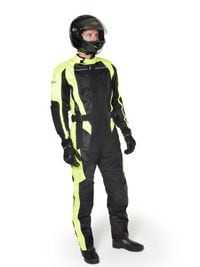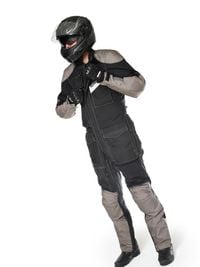Leather jackets and pants once ruled the road, but now textile riding gear is the overwhelming favorite of riders looking for the best combination of price, protection, and convenience. But like the fabrics they’re made from, textile gear is more complicated than it looks, and so is choosing the right piece.
First, check the label to see what the outer shell is made of. “The most commonly used fabric today is polyester 600 (denier), especially at modest price points,” says Bruce Parker of Speed & Strength. “Poly jackets are a good value for the money. Polyester wears well, it’s UV-resistant, it’ll last for three of four years, and it washes well. If you’re looking at it from a pure what-if-I-crash standpoint, there are many variables. If that’s your real concern you should buy leather.”
Go up the price ladder a rung or two and you’ll find Cordura nylon. It has a higher melting point and more abrasion resistance than the same denier polyester. Kevin Rhea of Olympia Moto Sports is a proponent of Cordura. “A lot of riders today aren’t really educated so they’ll see a $150 polyester-based jacket and assume it’s good quality. But it’s substandard stuff.” He says if you must choose polyester, get the highest denier you can, but first: “Do your research. Go online to the forums and read the crash testimonials to see if a garment held up in a crash. You’re getting what you pay for.”
Next comes the right fit. “Most people tend to buy their jackets big,” says Parker. “They want their protective gear to fit like their casual wear.” But that’s not the best approach. Jackets and pants should fit snugly enough to keep the elbow, shoulder, and knee armor in place in a crash, but not so tight they constrict your movement. All-season riders should try on gear with all the liners in place, then again with the liners removed and the arm and waist tabs adjusted to take up the slack. Ride to a fitting, and ask if you can step outside and sit on your bike before you decide what to buy. Put on your helmet, too, to see if it rubs the jacket’s collar or shoulders in the riding position.
There are several ways to waterproof riding gear, including an outer shell coated with polyvinyl chloride (PVC) or backed with a breathable material like Gore-Tex, or with a sewn-in or zip-in waterproof liner. But as Richard Kimes of Helmet House (distributor of the Cortech and Tour Master brands) points out: “If you make a 100 percent waterproof jacket you’re going to get a very warm jacket.” Most jackets have vents, but some are more effective than others depending on your riding position, vent placement on the jacket, and whether your bike has a windscreen. Vents that let cooling air flow through the jacket should have waterproof zippers, and should also line up with zippered vents in the interior rain or thermal liner. Otherwise the air will just balloon the outer shell without cooling your torso.
Mesh gear warrants special concern. The mesh sections are the weakest, and much more likely to tear and abrade in a slide. “Make sure there’s solid reinforced fabric in the elbow and shoulder strike areas,” says Rhea. “There are some mesh jackets that are totally mesh. You might as well be riding in a pajama top.”
Armor in the elbows, shoulders, and knees is a must for protective riding gear. CE-approved armor is standard equipment in most jackets and pants today, and should be included in any gear you buy. Make sure the jacket’s back protector is CE-spec––some aren’t, even in jackets with CE armor elsewhere––and upgrade it if it’s not. A jacket that can be zipped to riding pants adds another layer of protection, preventing the jacket from riding up in case of a feet-first slide on your back.
Finally, take a close look at the stitching. “You want to see at least three areas of stitching, like an interior stitch and two rows of top stitching at all the major strike points,” says Rhea. Kimes adds, “You don’t want seams in the impact areas. You’re asking something that’s been cut in half and sewn back together to do the job of a uniform piece.”
Quick Facts
Denier is the weight in grams of 9000 meters of a given thread. The denier number is the industry standard for assessing a fabric's resistance to abrasion; the higher the denier the better. The material itself affects abrasion resistance, too. Heavy canvas jeans might feel tough, but they're no match for pants made from thinner, tougher material.














/cloudfront-us-east-1.images.arcpublishing.com/octane/S35YGSEMEZB4BLTDJTSZPF4GLA.jpg)
/cloudfront-us-east-1.images.arcpublishing.com/octane/5UOT6HPX2JFMRJAX6EH45AR4MQ.jpg)
/cloudfront-us-east-1.images.arcpublishing.com/octane/OKWOJWAKP5EP3OACCRRWPCIX2Q.jpg)
/cloudfront-us-east-1.images.arcpublishing.com/octane/2WF3SCE3NFBQXLDNJM7KMXA45E.jpg)
/cloudfront-us-east-1.images.arcpublishing.com/octane/G4MG6OUCJNBSHIS2MVVOTPX65E.jpg)
/cloudfront-us-east-1.images.arcpublishing.com/octane/IIGGWFOTOJGB7DB6DGBXCCMTDY.jpg)
/cloudfront-us-east-1.images.arcpublishing.com/octane/QSTCM6AVEZA5JJBUXNIQ3DSOF4.jpg)
/cloudfront-us-east-1.images.arcpublishing.com/octane/U4I7G625B5DMLF2DVIJDFZVV6M.jpg)
/cloudfront-us-east-1.images.arcpublishing.com/octane/B6XD6LS6IVCQPIU6HXDJSM3FHY.jpg)
/cloudfront-us-east-1.images.arcpublishing.com/octane/ICL63FEDDRDTTMINYICCEYGMDA.jpg)
/cloudfront-us-east-1.images.arcpublishing.com/octane/FCGZHQXRBZFLBAPC5SDIQLVF4I.jpg)
/cloudfront-us-east-1.images.arcpublishing.com/octane/WNOB6LDOIFFHJKPSVIWDYUGOPM.jpg)

/cloudfront-us-east-1.images.arcpublishing.com/octane/X33NU3E525ECRHXLNUJN2FTRKI.jpg)
/cloudfront-us-east-1.images.arcpublishing.com/octane/6KKT5NNL2JAVBOXMZYS5ZO76YA.jpg)
/cloudfront-us-east-1.images.arcpublishing.com/octane/J5RKG5O455GMPGQRF2OG6LRT7A.jpg)
/cloudfront-us-east-1.images.arcpublishing.com/octane/GX2CIZKQVRH2TATDM26KFG2DAE.jpg)
/cloudfront-us-east-1.images.arcpublishing.com/octane/ZWIDYSAKQZHD5BHREMQILXJCGM.jpg)
/cloudfront-us-east-1.images.arcpublishing.com/octane/CYUHJZCTSJCH3MRAQEIKXK7SCQ.jpg)
/cloudfront-us-east-1.images.arcpublishing.com/octane/LKOFINY56FCXJCANJ5M7ZDQUBY.jpg)
/cloudfront-us-east-1.images.arcpublishing.com/octane/4NBPDACMWJH63JQYJVK3QRBDZI.jpg)
/cloudfront-us-east-1.images.arcpublishing.com/octane/KKHQHRR3FJGX7H2IPU6RALMWG4.jpg)

/cloudfront-us-east-1.images.arcpublishing.com/octane/5IOFS5JAE5FOXMNA23ZRAVVYUU.jpg)